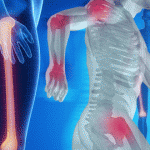Recently, an FDA committee announced support for the approval of CT-P13, an infliximab biosimilar. The FDA has also fast tracked the development of a fibromyalgia treatment designed for multiple symptoms…


Recently, an FDA committee announced support for the approval of CT-P13, an infliximab biosimilar. The FDA has also fast tracked the development of a fibromyalgia treatment designed for multiple symptoms…

Marie B. Corkery, PT, DPT, MHS, & Lauren Tarsi, DPT |
Fibromyalgia syndrome (FMS) is a condition characterized by widespread pain, abnormal pain processing, sleep disturbance and fatigue. It is commonly associated with psychological distress and co-morbid conditions. Impaired cognition is common in individuals with FMS, and is often referred to as fibrofog.1 According to the U.S. Centers for Disease Control and Prevention, the prevalence of…

Pain can be reduced and functionality significantly improved for children with fibromyalgia without drug therapy, according to a study of 64 children in Philadelphia. Researchers combined intensive physical therapy and psychotherapy in individualized programs to treat the fibromyalgia patients…
A 65-year-old established female patient returns to the office for a follow-up visit for her diagnosis of fibromyalgia. She complains of pain, stiffness and swelling in her left hand, elbow and neck that is persistent since her last visit. The pain is considerably worse in the morning. She denies any fevers, cough or dyspnea. The…
Take the challenge. CPT codes: 99213-25, 20553, 73120/LT Diagnosis: ICD-9 7291 ICD-10 M79.7 Coding for trigger-point injections continues to create a lot of confusion on proper coding guidelines. Keep in mind, two CPT4 codes can be used for trigger-point procedures: 20552—Injection(s); single or multiple trigger point(s), one or two muscle(s); and 20553—Single or multiple trigger…

Bruce Rothschild, MD |
Sleep disturbance is an important medical problem, requiring intervention, not simply to reduce latency to its onset, but to ensure achievement of the depth of sleep that has been documented to restore homeostasis and prevent the falls that are responsible for so much morbidity and mortality.1 Sleep disturbance is present in 50% of people over…
Fibromyalgia syndrome (FMS), rheumatoid arthritis (RA) and spondyloarthritis (SpA) all exhibit multifaceted manifestations, and many patients exhibit overlapping comorbidities. However, patients with FMS are distinct from others in that they experience widespread pain, fatigue and mood changes, including anxiety and depression. Although its hallmark symptom of pain causes rheumatologists to consider FMS a pain disorder,…
Staff |
New research shows that patients with fibromyalgia have hypersensitivity to non-painful events based on images of the patients’ brains, which show reduced activation in primary sensory regions and increased activation in sensory integration areas.
Research suggests weakened sensory cortex connectivity extending beyond the traditional somatosensory domain may contribute to pain associated with fibromyalgia
Researchers show, for the first time, that small fiber function and morphology is impaired in patients with fibromyalgia. (posted June 18, 2013)